University Nursing Assignment: Critical Analysis of Qualitative Paper
VerifiedAdded on 2023/01/03
|10
|2693
|86
Homework Assignment
AI Summary
This assignment provides a comprehensive critical analysis of a qualitative research paper titled "Nurses’ perceptions of climate and environmental issues: a qualitative study" by AnAaker et al. (2015). The analysis evaluates various aspects of the study, including the clarity of the research aim, the appropriateness of the selected qualitative methodology (descriptive explorative qualitative study), and the alignment of the research methods (semi-structured in-depth interviews and focus group interviews) with the study's objectives. The assignment assesses the description of inclusion criteria, sampling approach (purposive sampling), and data collection methods, including the justification of the settings and the handling of data saturation. Ethical considerations, such as obtaining informed consent, are examined. The analysis also delves into the data analysis process, including the use of the framework method and the generation of themes, evaluating the credibility and value of the research findings. The assignment concludes by discussing the relevance and limitations of the study within the healthcare context, emphasizing the potential impact on nursing practice and patient care.
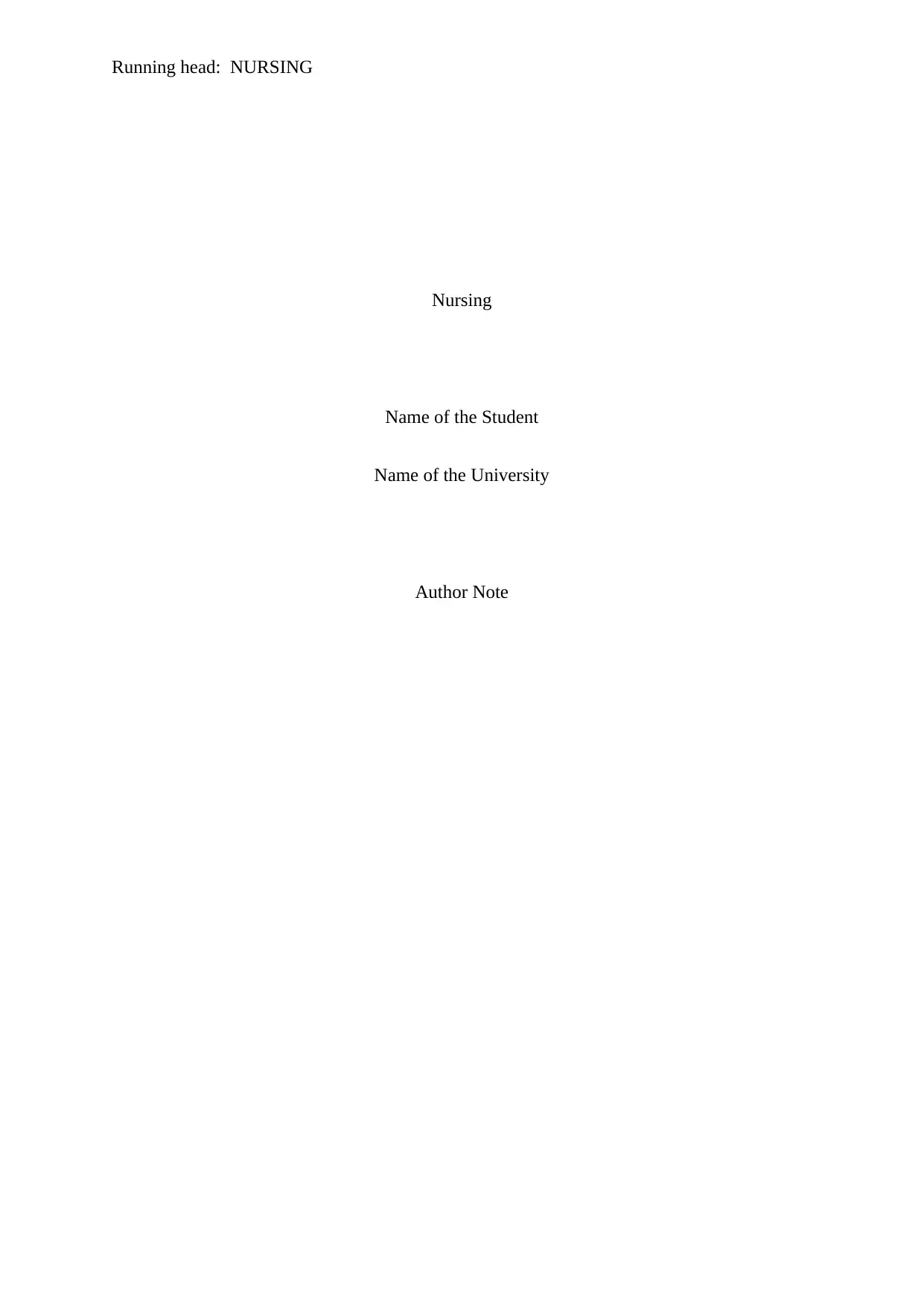
Running head: NURSING
Nursing
Name of the Student
Name of the University
Author Note
Nursing
Name of the Student
Name of the University
Author Note
Paraphrase This Document
Need a fresh take? Get an instant paraphrase of this document with our AI Paraphraser
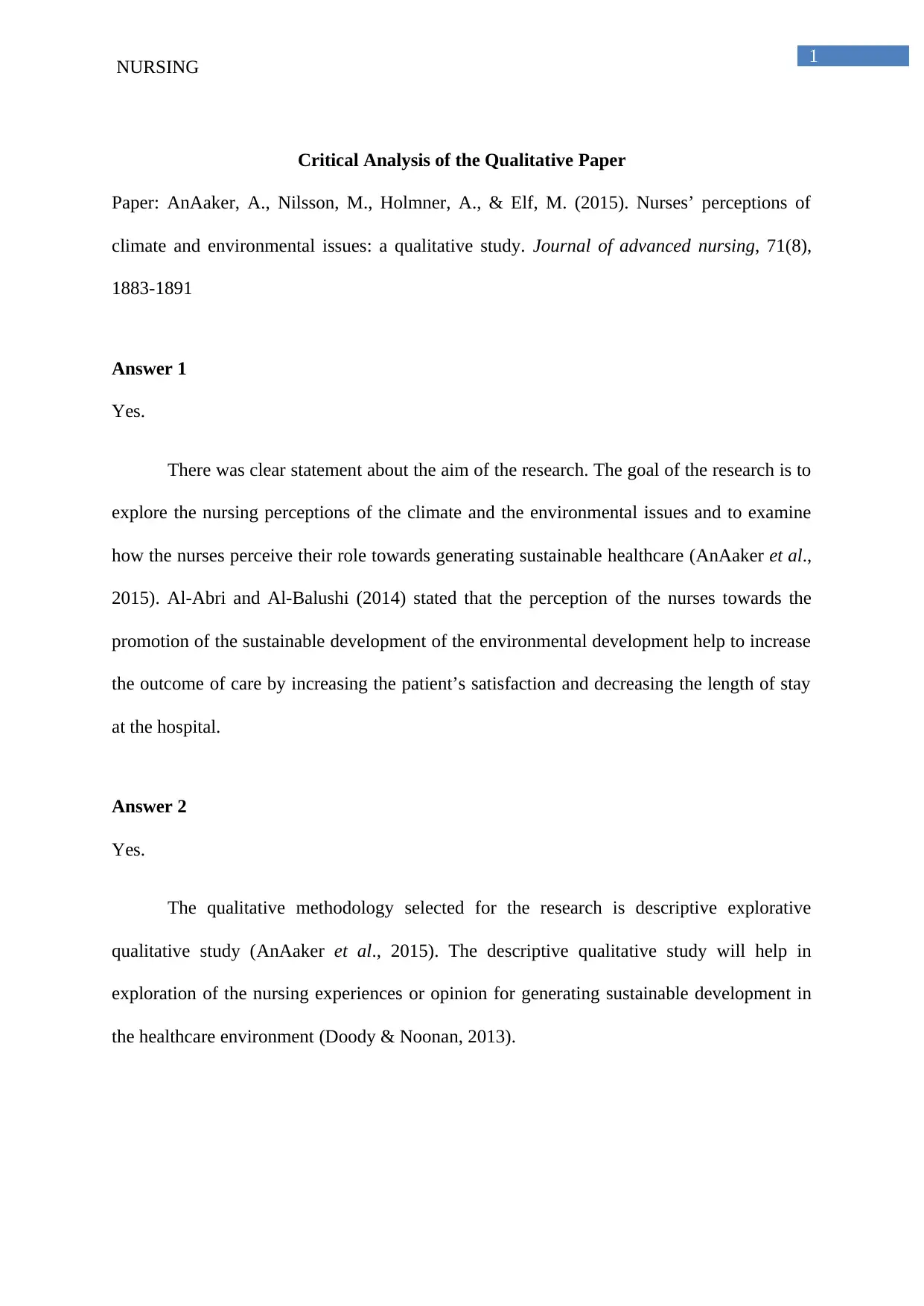
1
NURSING
Critical Analysis of the Qualitative Paper
Paper: AnAaker, A., Nilsson, M., Holmner, A., & Elf, M. (2015). Nurses’ perceptions of
climate and environmental issues: a qualitative study. Journal of advanced nursing, 71(8),
1883-1891
Answer 1
Yes.
There was clear statement about the aim of the research. The goal of the research is to
explore the nursing perceptions of the climate and the environmental issues and to examine
how the nurses perceive their role towards generating sustainable healthcare (AnAaker et al.,
2015). Al-Abri and Al-Balushi (2014) stated that the perception of the nurses towards the
promotion of the sustainable development of the environmental development help to increase
the outcome of care by increasing the patient’s satisfaction and decreasing the length of stay
at the hospital.
Answer 2
Yes.
The qualitative methodology selected for the research is descriptive explorative
qualitative study (AnAaker et al., 2015). The descriptive qualitative study will help in
exploration of the nursing experiences or opinion for generating sustainable development in
the healthcare environment (Doody & Noonan, 2013).
NURSING
Critical Analysis of the Qualitative Paper
Paper: AnAaker, A., Nilsson, M., Holmner, A., & Elf, M. (2015). Nurses’ perceptions of
climate and environmental issues: a qualitative study. Journal of advanced nursing, 71(8),
1883-1891
Answer 1
Yes.
There was clear statement about the aim of the research. The goal of the research is to
explore the nursing perceptions of the climate and the environmental issues and to examine
how the nurses perceive their role towards generating sustainable healthcare (AnAaker et al.,
2015). Al-Abri and Al-Balushi (2014) stated that the perception of the nurses towards the
promotion of the sustainable development of the environmental development help to increase
the outcome of care by increasing the patient’s satisfaction and decreasing the length of stay
at the hospital.
Answer 2
Yes.
The qualitative methodology selected for the research is descriptive explorative
qualitative study (AnAaker et al., 2015). The descriptive qualitative study will help in
exploration of the nursing experiences or opinion for generating sustainable development in
the healthcare environment (Doody & Noonan, 2013).
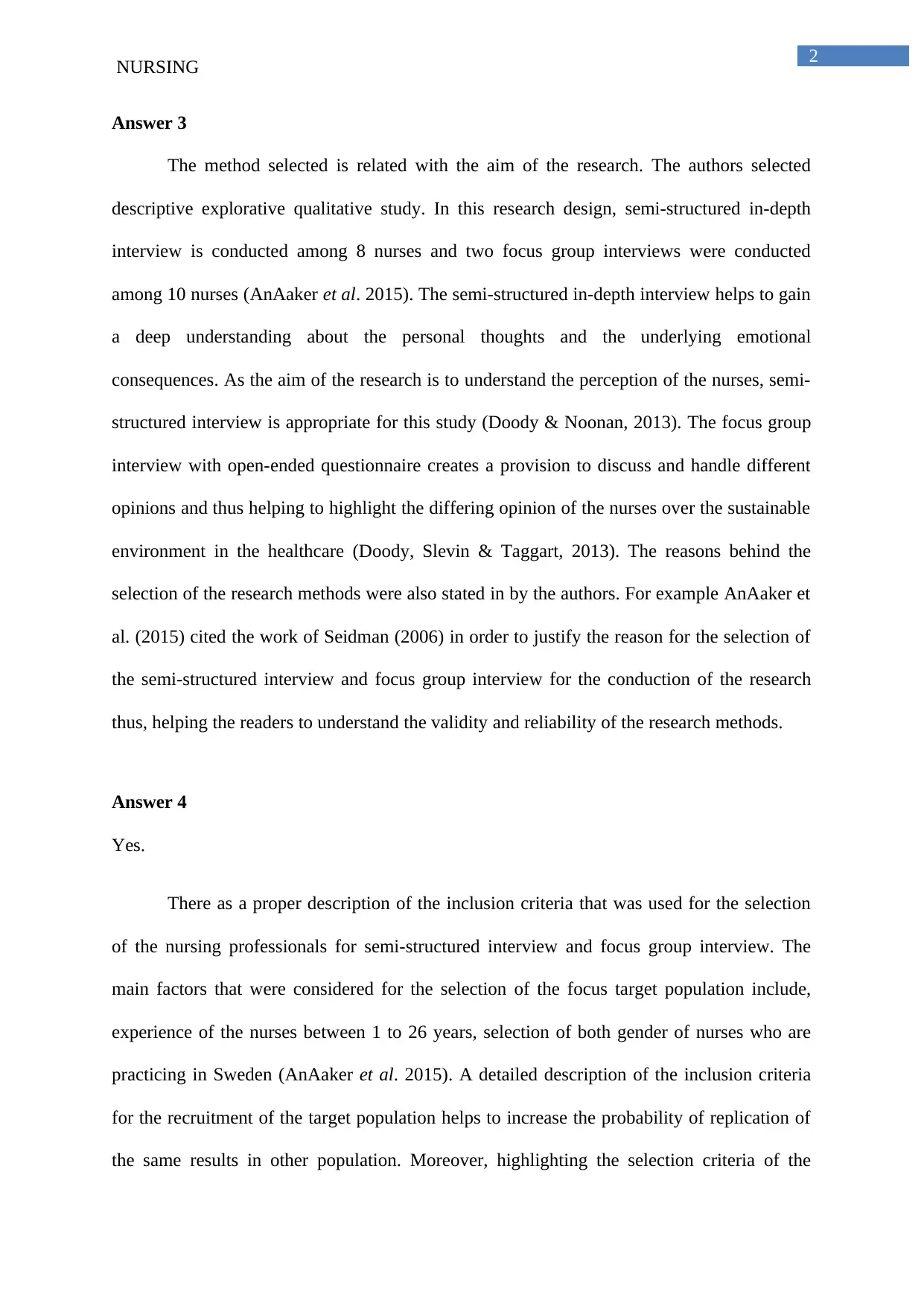
2
NURSING
Answer 3
The method selected is related with the aim of the research. The authors selected
descriptive explorative qualitative study. In this research design, semi-structured in-depth
interview is conducted among 8 nurses and two focus group interviews were conducted
among 10 nurses (AnAaker et al. 2015). The semi-structured in-depth interview helps to gain
a deep understanding about the personal thoughts and the underlying emotional
consequences. As the aim of the research is to understand the perception of the nurses, semi-
structured interview is appropriate for this study (Doody & Noonan, 2013). The focus group
interview with open-ended questionnaire creates a provision to discuss and handle different
opinions and thus helping to highlight the differing opinion of the nurses over the sustainable
environment in the healthcare (Doody, Slevin & Taggart, 2013). The reasons behind the
selection of the research methods were also stated in by the authors. For example AnAaker et
al. (2015) cited the work of Seidman (2006) in order to justify the reason for the selection of
the semi-structured interview and focus group interview for the conduction of the research
thus, helping the readers to understand the validity and reliability of the research methods.
Answer 4
Yes.
There as a proper description of the inclusion criteria that was used for the selection
of the nursing professionals for semi-structured interview and focus group interview. The
main factors that were considered for the selection of the focus target population include,
experience of the nurses between 1 to 26 years, selection of both gender of nurses who are
practicing in Sweden (AnAaker et al. 2015). A detailed description of the inclusion criteria
for the recruitment of the target population helps to increase the probability of replication of
the same results in other population. Moreover, highlighting the selection criteria of the
NURSING
Answer 3
The method selected is related with the aim of the research. The authors selected
descriptive explorative qualitative study. In this research design, semi-structured in-depth
interview is conducted among 8 nurses and two focus group interviews were conducted
among 10 nurses (AnAaker et al. 2015). The semi-structured in-depth interview helps to gain
a deep understanding about the personal thoughts and the underlying emotional
consequences. As the aim of the research is to understand the perception of the nurses, semi-
structured interview is appropriate for this study (Doody & Noonan, 2013). The focus group
interview with open-ended questionnaire creates a provision to discuss and handle different
opinions and thus helping to highlight the differing opinion of the nurses over the sustainable
environment in the healthcare (Doody, Slevin & Taggart, 2013). The reasons behind the
selection of the research methods were also stated in by the authors. For example AnAaker et
al. (2015) cited the work of Seidman (2006) in order to justify the reason for the selection of
the semi-structured interview and focus group interview for the conduction of the research
thus, helping the readers to understand the validity and reliability of the research methods.
Answer 4
Yes.
There as a proper description of the inclusion criteria that was used for the selection
of the nursing professionals for semi-structured interview and focus group interview. The
main factors that were considered for the selection of the focus target population include,
experience of the nurses between 1 to 26 years, selection of both gender of nurses who are
practicing in Sweden (AnAaker et al. 2015). A detailed description of the inclusion criteria
for the recruitment of the target population helps to increase the probability of replication of
the same results in other population. Moreover, highlighting the selection criteria of the
⊘ This is a preview!⊘
Do you want full access?
Subscribe today to unlock all pages.

Trusted by 1+ million students worldwide
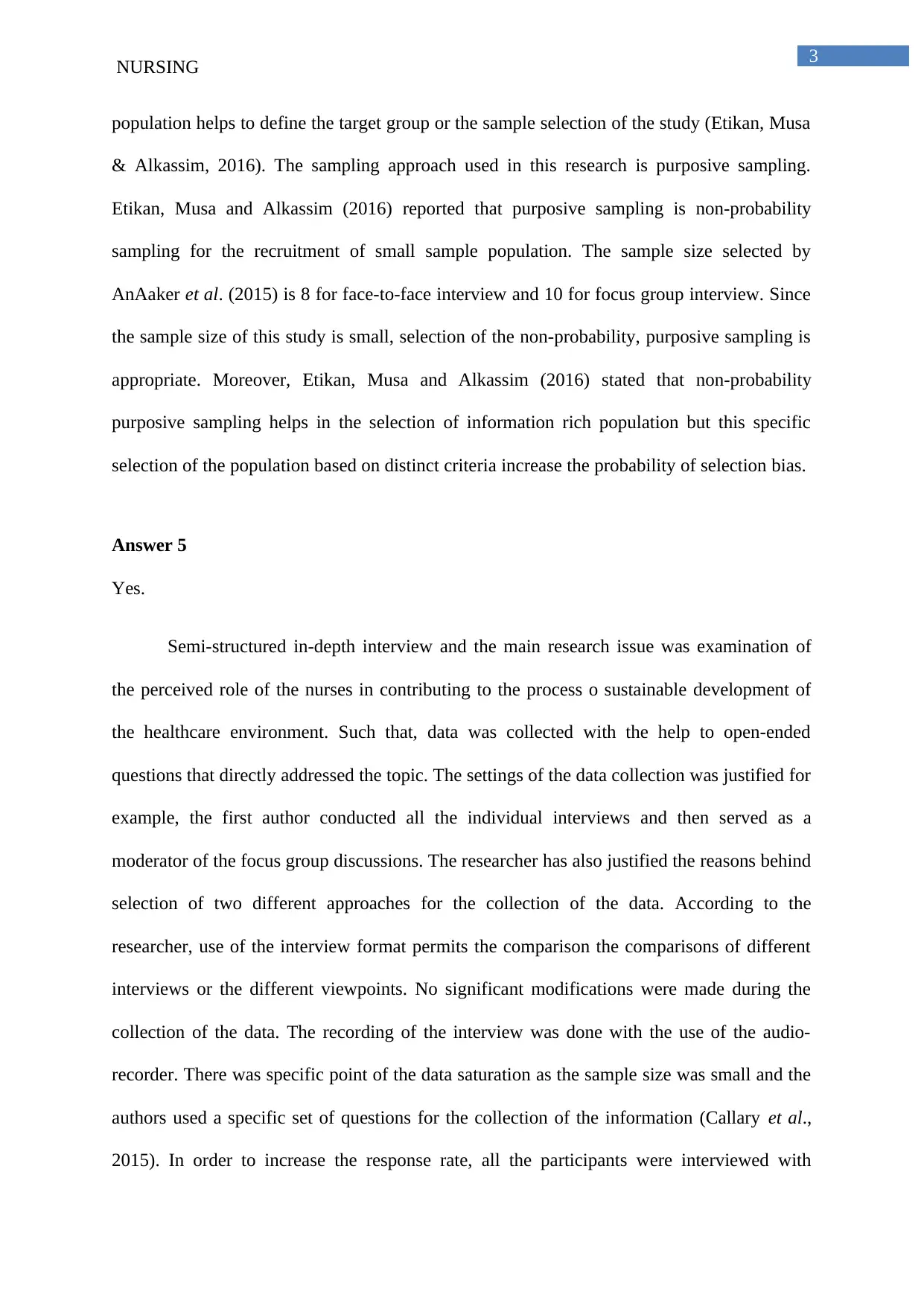
3
NURSING
population helps to define the target group or the sample selection of the study (Etikan, Musa
& Alkassim, 2016). The sampling approach used in this research is purposive sampling.
Etikan, Musa and Alkassim (2016) reported that purposive sampling is non-probability
sampling for the recruitment of small sample population. The sample size selected by
AnAaker et al. (2015) is 8 for face-to-face interview and 10 for focus group interview. Since
the sample size of this study is small, selection of the non-probability, purposive sampling is
appropriate. Moreover, Etikan, Musa and Alkassim (2016) stated that non-probability
purposive sampling helps in the selection of information rich population but this specific
selection of the population based on distinct criteria increase the probability of selection bias.
Answer 5
Yes.
Semi-structured in-depth interview and the main research issue was examination of
the perceived role of the nurses in contributing to the process o sustainable development of
the healthcare environment. Such that, data was collected with the help to open-ended
questions that directly addressed the topic. The settings of the data collection was justified for
example, the first author conducted all the individual interviews and then served as a
moderator of the focus group discussions. The researcher has also justified the reasons behind
selection of two different approaches for the collection of the data. According to the
researcher, use of the interview format permits the comparison the comparisons of different
interviews or the different viewpoints. No significant modifications were made during the
collection of the data. The recording of the interview was done with the use of the audio-
recorder. There was specific point of the data saturation as the sample size was small and the
authors used a specific set of questions for the collection of the information (Callary et al.,
2015). In order to increase the response rate, all the participants were interviewed with
NURSING
population helps to define the target group or the sample selection of the study (Etikan, Musa
& Alkassim, 2016). The sampling approach used in this research is purposive sampling.
Etikan, Musa and Alkassim (2016) reported that purposive sampling is non-probability
sampling for the recruitment of small sample population. The sample size selected by
AnAaker et al. (2015) is 8 for face-to-face interview and 10 for focus group interview. Since
the sample size of this study is small, selection of the non-probability, purposive sampling is
appropriate. Moreover, Etikan, Musa and Alkassim (2016) stated that non-probability
purposive sampling helps in the selection of information rich population but this specific
selection of the population based on distinct criteria increase the probability of selection bias.
Answer 5
Yes.
Semi-structured in-depth interview and the main research issue was examination of
the perceived role of the nurses in contributing to the process o sustainable development of
the healthcare environment. Such that, data was collected with the help to open-ended
questions that directly addressed the topic. The settings of the data collection was justified for
example, the first author conducted all the individual interviews and then served as a
moderator of the focus group discussions. The researcher has also justified the reasons behind
selection of two different approaches for the collection of the data. According to the
researcher, use of the interview format permits the comparison the comparisons of different
interviews or the different viewpoints. No significant modifications were made during the
collection of the data. The recording of the interview was done with the use of the audio-
recorder. There was specific point of the data saturation as the sample size was small and the
authors used a specific set of questions for the collection of the information (Callary et al.,
2015). In order to increase the response rate, all the participants were interviewed with
Paraphrase This Document
Need a fresh take? Get an instant paraphrase of this document with our AI Paraphraser
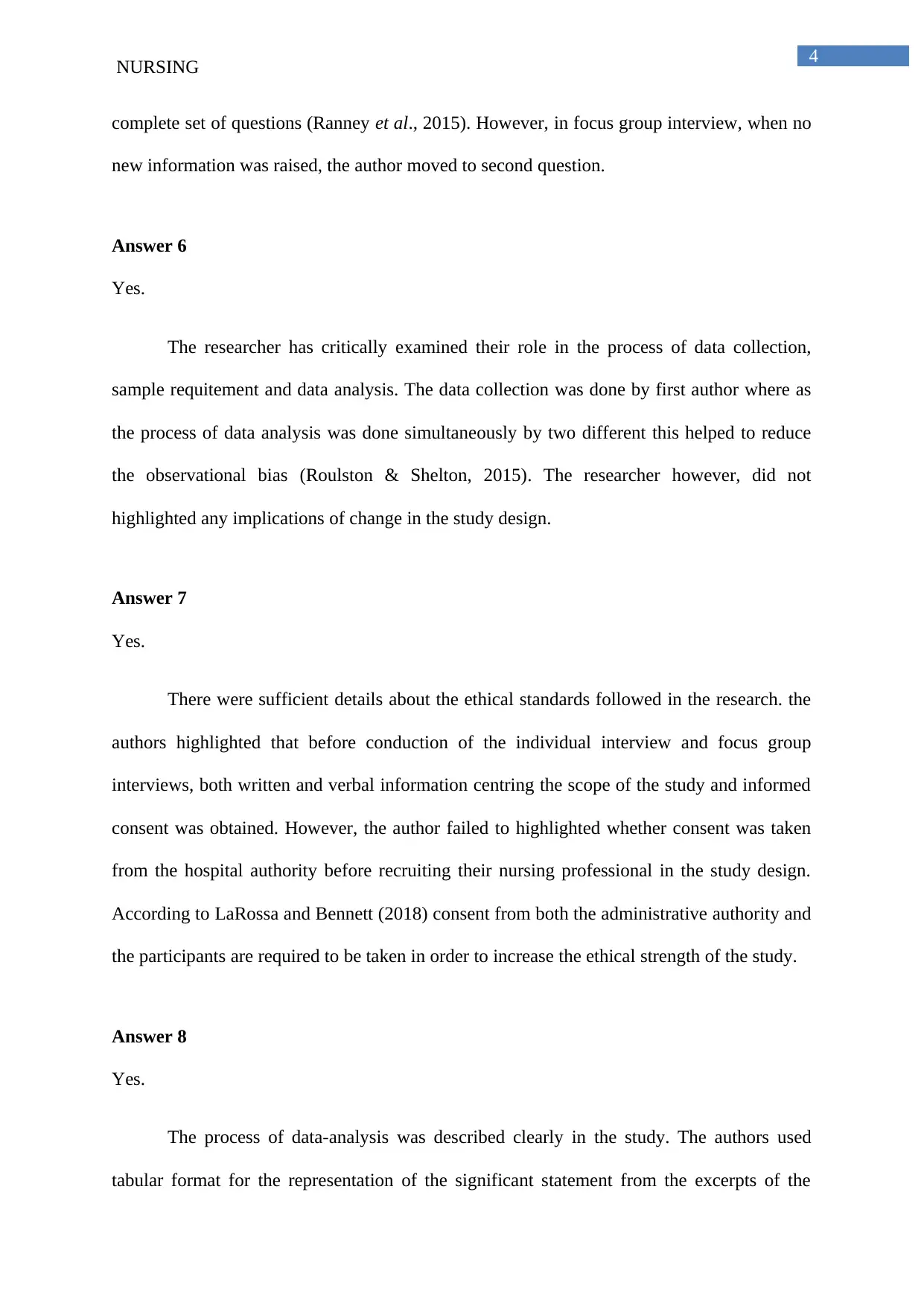
4
NURSING
complete set of questions (Ranney et al., 2015). However, in focus group interview, when no
new information was raised, the author moved to second question.
Answer 6
Yes.
The researcher has critically examined their role in the process of data collection,
sample requitement and data analysis. The data collection was done by first author where as
the process of data analysis was done simultaneously by two different this helped to reduce
the observational bias (Roulston & Shelton, 2015). The researcher however, did not
highlighted any implications of change in the study design.
Answer 7
Yes.
There were sufficient details about the ethical standards followed in the research. the
authors highlighted that before conduction of the individual interview and focus group
interviews, both written and verbal information centring the scope of the study and informed
consent was obtained. However, the author failed to highlighted whether consent was taken
from the hospital authority before recruiting their nursing professional in the study design.
According to LaRossa and Bennett (2018) consent from both the administrative authority and
the participants are required to be taken in order to increase the ethical strength of the study.
Answer 8
Yes.
The process of data-analysis was described clearly in the study. The authors used
tabular format for the representation of the significant statement from the excerpts of the
NURSING
complete set of questions (Ranney et al., 2015). However, in focus group interview, when no
new information was raised, the author moved to second question.
Answer 6
Yes.
The researcher has critically examined their role in the process of data collection,
sample requitement and data analysis. The data collection was done by first author where as
the process of data analysis was done simultaneously by two different this helped to reduce
the observational bias (Roulston & Shelton, 2015). The researcher however, did not
highlighted any implications of change in the study design.
Answer 7
Yes.
There were sufficient details about the ethical standards followed in the research. the
authors highlighted that before conduction of the individual interview and focus group
interviews, both written and verbal information centring the scope of the study and informed
consent was obtained. However, the author failed to highlighted whether consent was taken
from the hospital authority before recruiting their nursing professional in the study design.
According to LaRossa and Bennett (2018) consent from both the administrative authority and
the participants are required to be taken in order to increase the ethical strength of the study.
Answer 8
Yes.
The process of data-analysis was described clearly in the study. The authors used
tabular format for the representation of the significant statement from the excerpts of the
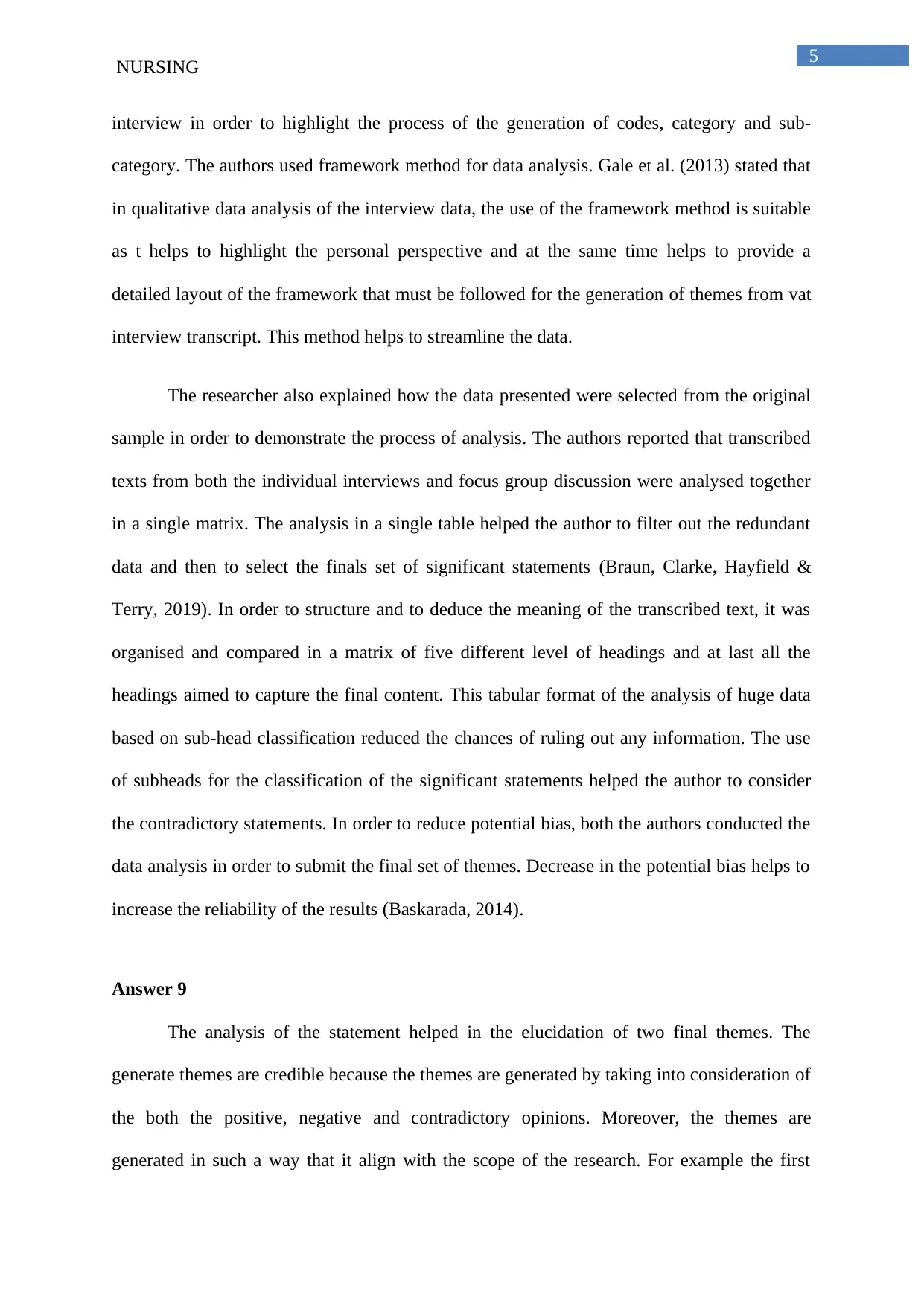
5
NURSING
interview in order to highlight the process of the generation of codes, category and sub-
category. The authors used framework method for data analysis. Gale et al. (2013) stated that
in qualitative data analysis of the interview data, the use of the framework method is suitable
as t helps to highlight the personal perspective and at the same time helps to provide a
detailed layout of the framework that must be followed for the generation of themes from vat
interview transcript. This method helps to streamline the data.
The researcher also explained how the data presented were selected from the original
sample in order to demonstrate the process of analysis. The authors reported that transcribed
texts from both the individual interviews and focus group discussion were analysed together
in a single matrix. The analysis in a single table helped the author to filter out the redundant
data and then to select the finals set of significant statements (Braun, Clarke, Hayfield &
Terry, 2019). In order to structure and to deduce the meaning of the transcribed text, it was
organised and compared in a matrix of five different level of headings and at last all the
headings aimed to capture the final content. This tabular format of the analysis of huge data
based on sub-head classification reduced the chances of ruling out any information. The use
of subheads for the classification of the significant statements helped the author to consider
the contradictory statements. In order to reduce potential bias, both the authors conducted the
data analysis in order to submit the final set of themes. Decrease in the potential bias helps to
increase the reliability of the results (Baskarada, 2014).
Answer 9
The analysis of the statement helped in the elucidation of two final themes. The
generate themes are credible because the themes are generated by taking into consideration of
the both the positive, negative and contradictory opinions. Moreover, the themes are
generated in such a way that it align with the scope of the research. For example the first
NURSING
interview in order to highlight the process of the generation of codes, category and sub-
category. The authors used framework method for data analysis. Gale et al. (2013) stated that
in qualitative data analysis of the interview data, the use of the framework method is suitable
as t helps to highlight the personal perspective and at the same time helps to provide a
detailed layout of the framework that must be followed for the generation of themes from vat
interview transcript. This method helps to streamline the data.
The researcher also explained how the data presented were selected from the original
sample in order to demonstrate the process of analysis. The authors reported that transcribed
texts from both the individual interviews and focus group discussion were analysed together
in a single matrix. The analysis in a single table helped the author to filter out the redundant
data and then to select the finals set of significant statements (Braun, Clarke, Hayfield &
Terry, 2019). In order to structure and to deduce the meaning of the transcribed text, it was
organised and compared in a matrix of five different level of headings and at last all the
headings aimed to capture the final content. This tabular format of the analysis of huge data
based on sub-head classification reduced the chances of ruling out any information. The use
of subheads for the classification of the significant statements helped the author to consider
the contradictory statements. In order to reduce potential bias, both the authors conducted the
data analysis in order to submit the final set of themes. Decrease in the potential bias helps to
increase the reliability of the results (Baskarada, 2014).
Answer 9
The analysis of the statement helped in the elucidation of two final themes. The
generate themes are credible because the themes are generated by taking into consideration of
the both the positive, negative and contradictory opinions. Moreover, the themes are
generated in such a way that it align with the scope of the research. For example the first
⊘ This is a preview!⊘
Do you want full access?
Subscribe today to unlock all pages.

Trusted by 1+ million students worldwide
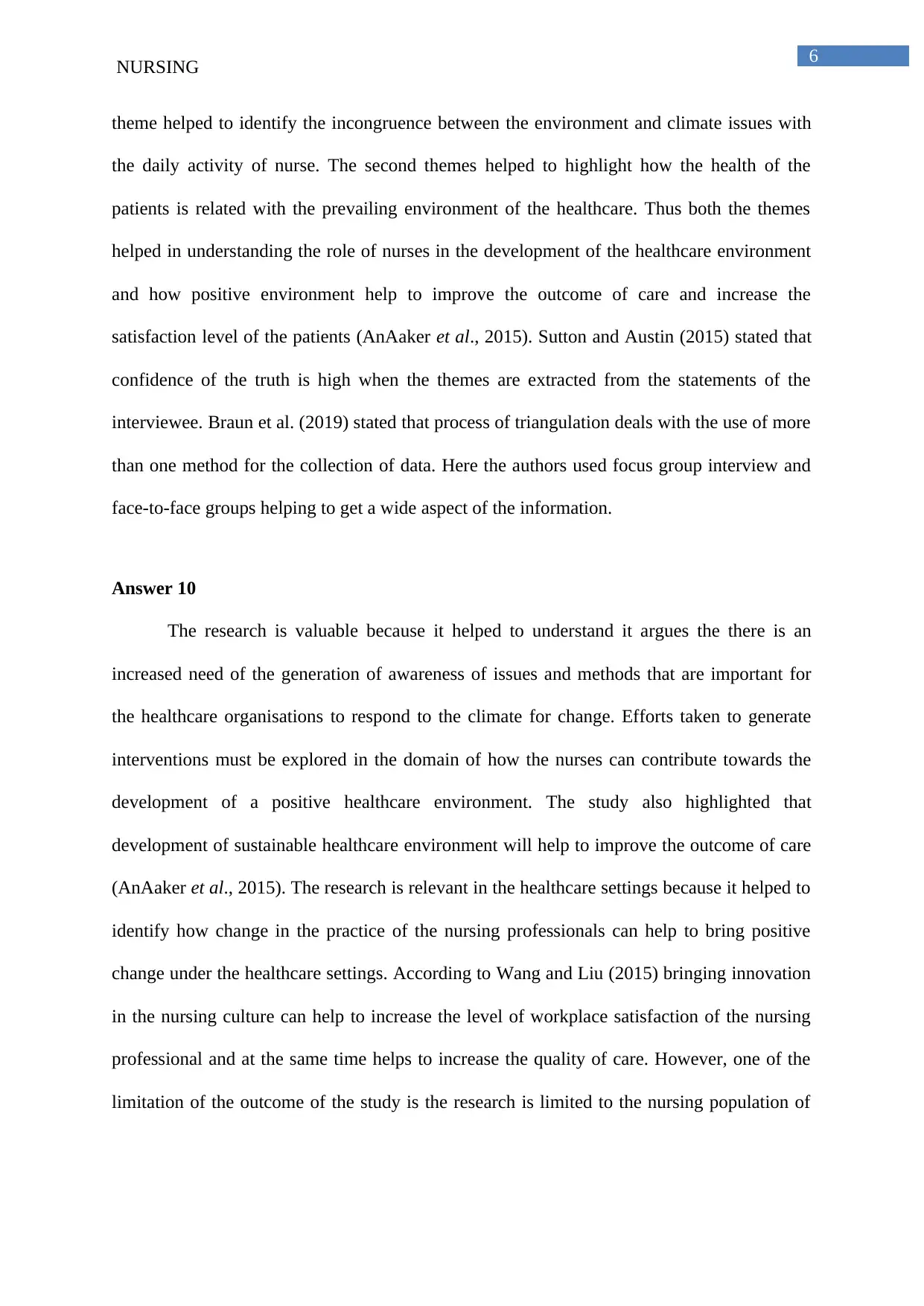
6
NURSING
theme helped to identify the incongruence between the environment and climate issues with
the daily activity of nurse. The second themes helped to highlight how the health of the
patients is related with the prevailing environment of the healthcare. Thus both the themes
helped in understanding the role of nurses in the development of the healthcare environment
and how positive environment help to improve the outcome of care and increase the
satisfaction level of the patients (AnAaker et al., 2015). Sutton and Austin (2015) stated that
confidence of the truth is high when the themes are extracted from the statements of the
interviewee. Braun et al. (2019) stated that process of triangulation deals with the use of more
than one method for the collection of data. Here the authors used focus group interview and
face-to-face groups helping to get a wide aspect of the information.
Answer 10
The research is valuable because it helped to understand it argues the there is an
increased need of the generation of awareness of issues and methods that are important for
the healthcare organisations to respond to the climate for change. Efforts taken to generate
interventions must be explored in the domain of how the nurses can contribute towards the
development of a positive healthcare environment. The study also highlighted that
development of sustainable healthcare environment will help to improve the outcome of care
(AnAaker et al., 2015). The research is relevant in the healthcare settings because it helped to
identify how change in the practice of the nursing professionals can help to bring positive
change under the healthcare settings. According to Wang and Liu (2015) bringing innovation
in the nursing culture can help to increase the level of workplace satisfaction of the nursing
professional and at the same time helps to increase the quality of care. However, one of the
limitation of the outcome of the study is the research is limited to the nursing population of
NURSING
theme helped to identify the incongruence between the environment and climate issues with
the daily activity of nurse. The second themes helped to highlight how the health of the
patients is related with the prevailing environment of the healthcare. Thus both the themes
helped in understanding the role of nurses in the development of the healthcare environment
and how positive environment help to improve the outcome of care and increase the
satisfaction level of the patients (AnAaker et al., 2015). Sutton and Austin (2015) stated that
confidence of the truth is high when the themes are extracted from the statements of the
interviewee. Braun et al. (2019) stated that process of triangulation deals with the use of more
than one method for the collection of data. Here the authors used focus group interview and
face-to-face groups helping to get a wide aspect of the information.
Answer 10
The research is valuable because it helped to understand it argues the there is an
increased need of the generation of awareness of issues and methods that are important for
the healthcare organisations to respond to the climate for change. Efforts taken to generate
interventions must be explored in the domain of how the nurses can contribute towards the
development of a positive healthcare environment. The study also highlighted that
development of sustainable healthcare environment will help to improve the outcome of care
(AnAaker et al., 2015). The research is relevant in the healthcare settings because it helped to
identify how change in the practice of the nursing professionals can help to bring positive
change under the healthcare settings. According to Wang and Liu (2015) bringing innovation
in the nursing culture can help to increase the level of workplace satisfaction of the nursing
professional and at the same time helps to increase the quality of care. However, one of the
limitation of the outcome of the study is the research is limited to the nursing population of
Paraphrase This Document
Need a fresh take? Get an instant paraphrase of this document with our AI Paraphraser
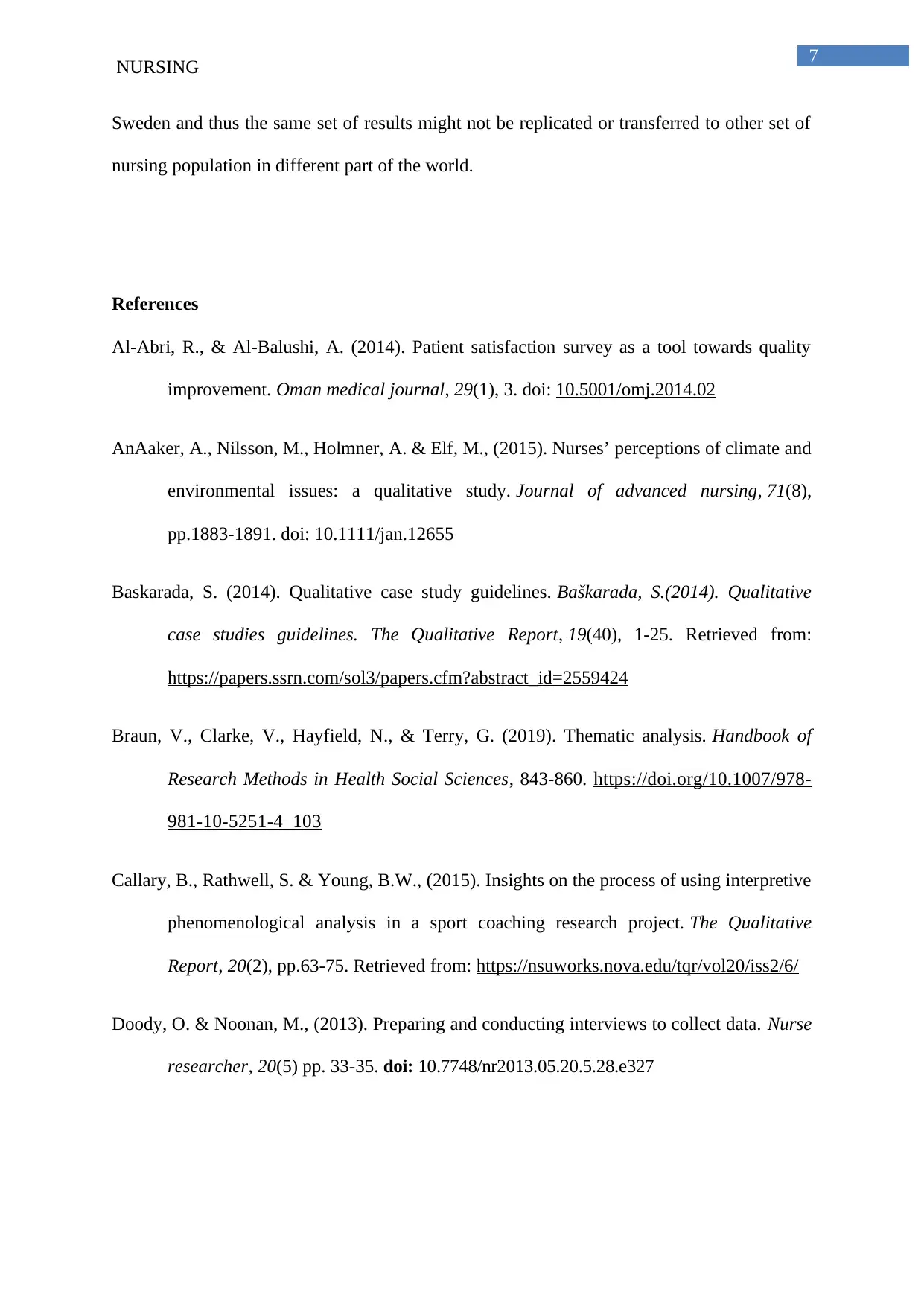
7
NURSING
Sweden and thus the same set of results might not be replicated or transferred to other set of
nursing population in different part of the world.
References
Al-Abri, R., & Al-Balushi, A. (2014). Patient satisfaction survey as a tool towards quality
improvement. Oman medical journal, 29(1), 3. doi: 10.5001/omj.2014.02
AnAaker, A., Nilsson, M., Holmner, A. & Elf, M., (2015). Nurses’ perceptions of climate and
environmental issues: a qualitative study. Journal of advanced nursing, 71(8),
pp.1883-1891. doi: 10.1111/jan.12655
Baskarada, S. (2014). Qualitative case study guidelines. Baškarada, S.(2014). Qualitative
case studies guidelines. The Qualitative Report, 19(40), 1-25. Retrieved from:
https://papers.ssrn.com/sol3/papers.cfm?abstract_id=2559424
Braun, V., Clarke, V., Hayfield, N., & Terry, G. (2019). Thematic analysis. Handbook of
Research Methods in Health Social Sciences, 843-860. https://doi.org/10.1007/978-
981-10-5251-4_103
Callary, B., Rathwell, S. & Young, B.W., (2015). Insights on the process of using interpretive
phenomenological analysis in a sport coaching research project. The Qualitative
Report, 20(2), pp.63-75. Retrieved from: https://nsuworks.nova.edu/tqr/vol20/iss2/6/
Doody, O. & Noonan, M., (2013). Preparing and conducting interviews to collect data. Nurse
researcher, 20(5) pp. 33-35. doi: 10.7748/nr2013.05.20.5.28.e327
NURSING
Sweden and thus the same set of results might not be replicated or transferred to other set of
nursing population in different part of the world.
References
Al-Abri, R., & Al-Balushi, A. (2014). Patient satisfaction survey as a tool towards quality
improvement. Oman medical journal, 29(1), 3. doi: 10.5001/omj.2014.02
AnAaker, A., Nilsson, M., Holmner, A. & Elf, M., (2015). Nurses’ perceptions of climate and
environmental issues: a qualitative study. Journal of advanced nursing, 71(8),
pp.1883-1891. doi: 10.1111/jan.12655
Baskarada, S. (2014). Qualitative case study guidelines. Baškarada, S.(2014). Qualitative
case studies guidelines. The Qualitative Report, 19(40), 1-25. Retrieved from:
https://papers.ssrn.com/sol3/papers.cfm?abstract_id=2559424
Braun, V., Clarke, V., Hayfield, N., & Terry, G. (2019). Thematic analysis. Handbook of
Research Methods in Health Social Sciences, 843-860. https://doi.org/10.1007/978-
981-10-5251-4_103
Callary, B., Rathwell, S. & Young, B.W., (2015). Insights on the process of using interpretive
phenomenological analysis in a sport coaching research project. The Qualitative
Report, 20(2), pp.63-75. Retrieved from: https://nsuworks.nova.edu/tqr/vol20/iss2/6/
Doody, O. & Noonan, M., (2013). Preparing and conducting interviews to collect data. Nurse
researcher, 20(5) pp. 33-35. doi: 10.7748/nr2013.05.20.5.28.e327
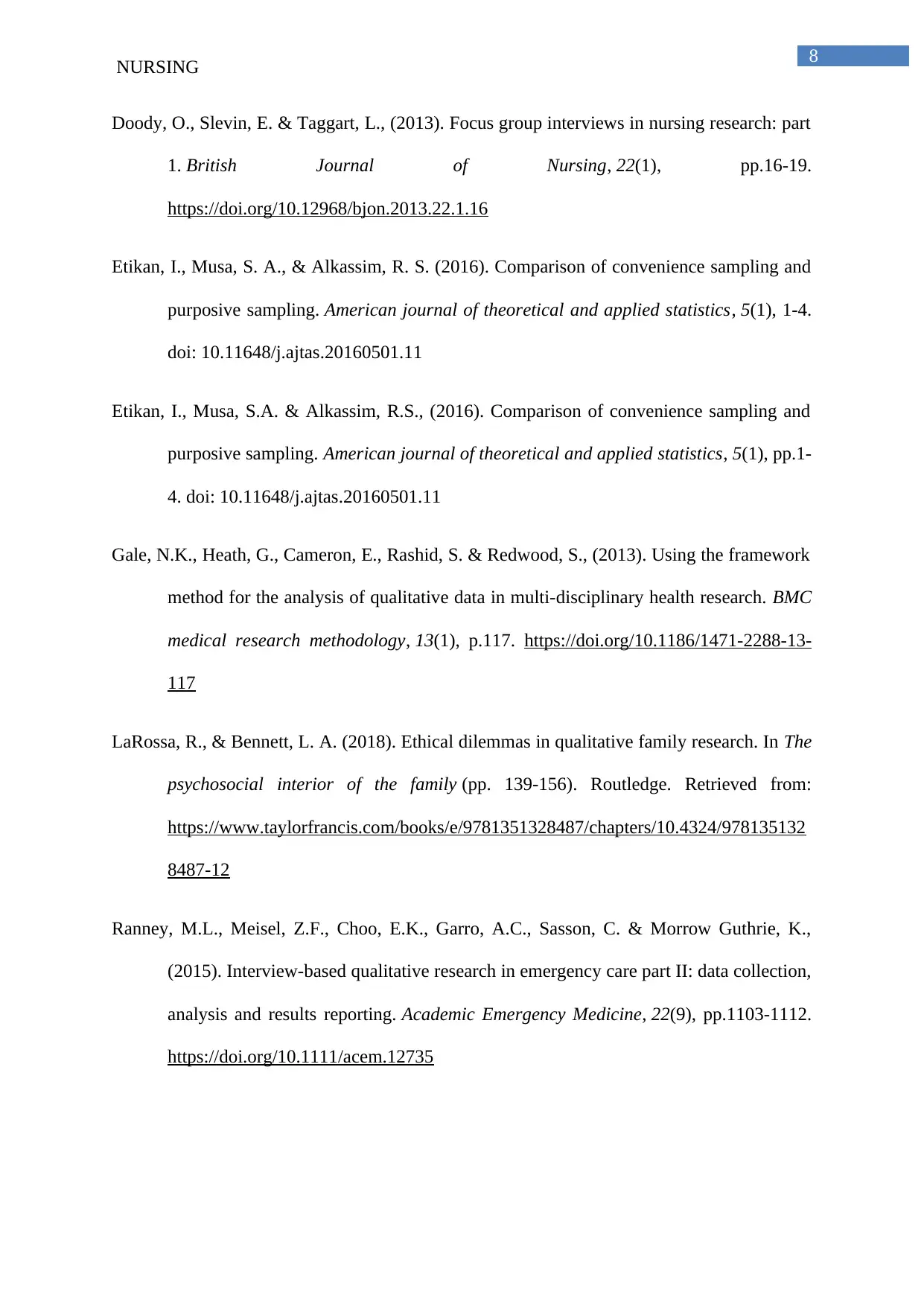
8
NURSING
Doody, O., Slevin, E. & Taggart, L., (2013). Focus group interviews in nursing research: part
1. British Journal of Nursing, 22(1), pp.16-19.
https://doi.org/10.12968/bjon.2013.22.1.16
Etikan, I., Musa, S. A., & Alkassim, R. S. (2016). Comparison of convenience sampling and
purposive sampling. American journal of theoretical and applied statistics, 5(1), 1-4.
doi: 10.11648/j.ajtas.20160501.11
Etikan, I., Musa, S.A. & Alkassim, R.S., (2016). Comparison of convenience sampling and
purposive sampling. American journal of theoretical and applied statistics, 5(1), pp.1-
4. doi: 10.11648/j.ajtas.20160501.11
Gale, N.K., Heath, G., Cameron, E., Rashid, S. & Redwood, S., (2013). Using the framework
method for the analysis of qualitative data in multi-disciplinary health research. BMC
medical research methodology, 13(1), p.117. https://doi.org/10.1186/1471-2288-13-
117
LaRossa, R., & Bennett, L. A. (2018). Ethical dilemmas in qualitative family research. In The
psychosocial interior of the family (pp. 139-156). Routledge. Retrieved from:
https://www.taylorfrancis.com/books/e/9781351328487/chapters/10.4324/978135132
8487-12
Ranney, M.L., Meisel, Z.F., Choo, E.K., Garro, A.C., Sasson, C. & Morrow Guthrie, K.,
(2015). Interview‐based qualitative research in emergency care part II: data collection,
analysis and results reporting. Academic Emergency Medicine, 22(9), pp.1103-1112.
https://doi.org/10.1111/acem.12735
NURSING
Doody, O., Slevin, E. & Taggart, L., (2013). Focus group interviews in nursing research: part
1. British Journal of Nursing, 22(1), pp.16-19.
https://doi.org/10.12968/bjon.2013.22.1.16
Etikan, I., Musa, S. A., & Alkassim, R. S. (2016). Comparison of convenience sampling and
purposive sampling. American journal of theoretical and applied statistics, 5(1), 1-4.
doi: 10.11648/j.ajtas.20160501.11
Etikan, I., Musa, S.A. & Alkassim, R.S., (2016). Comparison of convenience sampling and
purposive sampling. American journal of theoretical and applied statistics, 5(1), pp.1-
4. doi: 10.11648/j.ajtas.20160501.11
Gale, N.K., Heath, G., Cameron, E., Rashid, S. & Redwood, S., (2013). Using the framework
method for the analysis of qualitative data in multi-disciplinary health research. BMC
medical research methodology, 13(1), p.117. https://doi.org/10.1186/1471-2288-13-
117
LaRossa, R., & Bennett, L. A. (2018). Ethical dilemmas in qualitative family research. In The
psychosocial interior of the family (pp. 139-156). Routledge. Retrieved from:
https://www.taylorfrancis.com/books/e/9781351328487/chapters/10.4324/978135132
8487-12
Ranney, M.L., Meisel, Z.F., Choo, E.K., Garro, A.C., Sasson, C. & Morrow Guthrie, K.,
(2015). Interview‐based qualitative research in emergency care part II: data collection,
analysis and results reporting. Academic Emergency Medicine, 22(9), pp.1103-1112.
https://doi.org/10.1111/acem.12735
⊘ This is a preview!⊘
Do you want full access?
Subscribe today to unlock all pages.

Trusted by 1+ million students worldwide
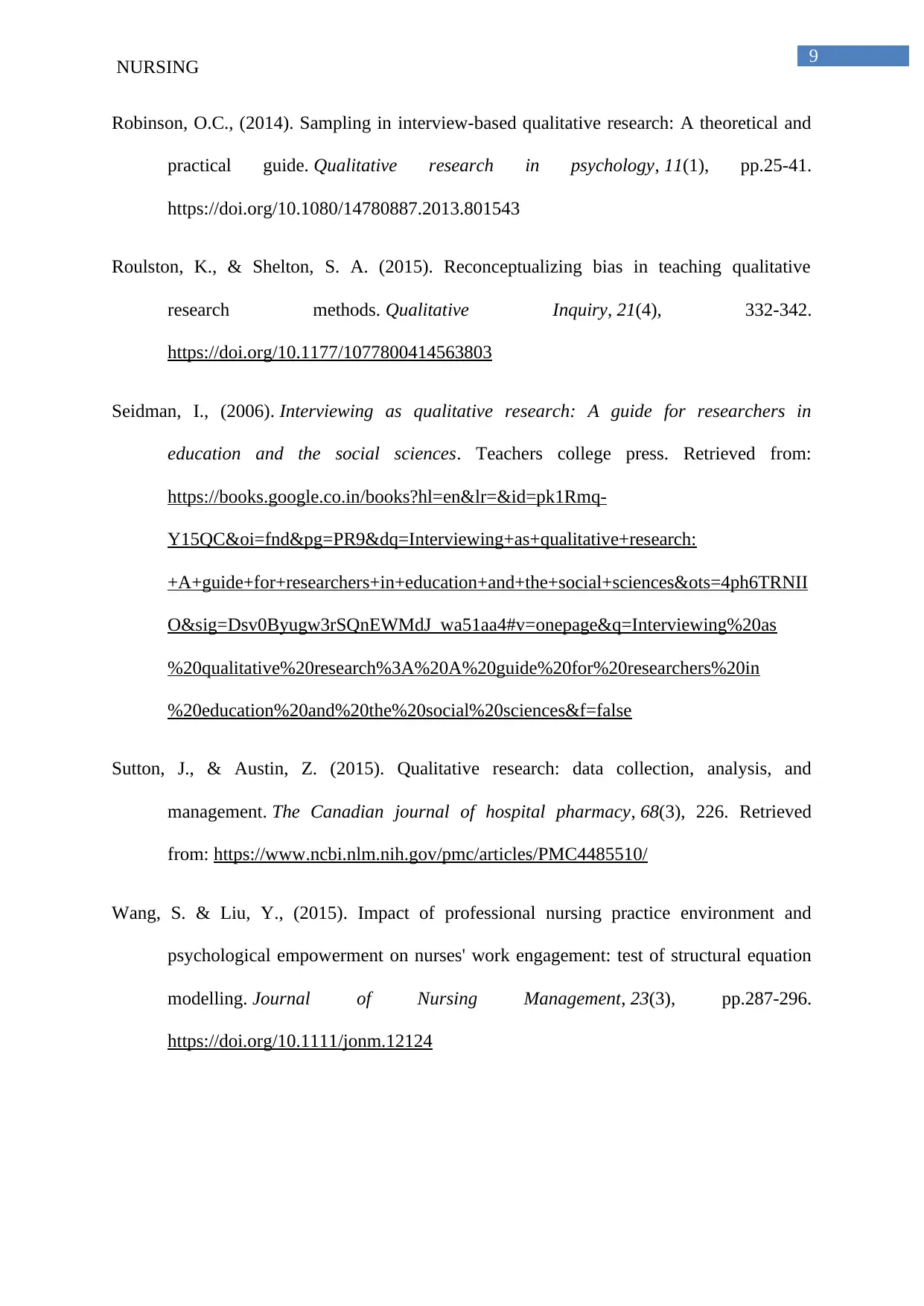
9
NURSING
Robinson, O.C., (2014). Sampling in interview-based qualitative research: A theoretical and
practical guide. Qualitative research in psychology, 11(1), pp.25-41.
https://doi.org/10.1080/14780887.2013.801543
Roulston, K., & Shelton, S. A. (2015). Reconceptualizing bias in teaching qualitative
research methods. Qualitative Inquiry, 21(4), 332-342.
https://doi.org/10.1177/1077800414563803
Seidman, I., (2006). Interviewing as qualitative research: A guide for researchers in
education and the social sciences. Teachers college press. Retrieved from:
https://books.google.co.in/books?hl=en&lr=&id=pk1Rmq-
Y15QC&oi=fnd&pg=PR9&dq=Interviewing+as+qualitative+research:
+A+guide+for+researchers+in+education+and+the+social+sciences&ots=4ph6TRNII
O&sig=Dsv0Byugw3rSQnEWMdJ_wa51aa4#v=onepage&q=Interviewing%20as
%20qualitative%20research%3A%20A%20guide%20for%20researchers%20in
%20education%20and%20the%20social%20sciences&f=false
Sutton, J., & Austin, Z. (2015). Qualitative research: data collection, analysis, and
management. The Canadian journal of hospital pharmacy, 68(3), 226. Retrieved
from: https://www.ncbi.nlm.nih.gov/pmc/articles/PMC4485510/
Wang, S. & Liu, Y., (2015). Impact of professional nursing practice environment and
psychological empowerment on nurses' work engagement: test of structural equation
modelling. Journal of Nursing Management, 23(3), pp.287-296.
https://doi.org/10.1111/jonm.12124
NURSING
Robinson, O.C., (2014). Sampling in interview-based qualitative research: A theoretical and
practical guide. Qualitative research in psychology, 11(1), pp.25-41.
https://doi.org/10.1080/14780887.2013.801543
Roulston, K., & Shelton, S. A. (2015). Reconceptualizing bias in teaching qualitative
research methods. Qualitative Inquiry, 21(4), 332-342.
https://doi.org/10.1177/1077800414563803
Seidman, I., (2006). Interviewing as qualitative research: A guide for researchers in
education and the social sciences. Teachers college press. Retrieved from:
https://books.google.co.in/books?hl=en&lr=&id=pk1Rmq-
Y15QC&oi=fnd&pg=PR9&dq=Interviewing+as+qualitative+research:
+A+guide+for+researchers+in+education+and+the+social+sciences&ots=4ph6TRNII
O&sig=Dsv0Byugw3rSQnEWMdJ_wa51aa4#v=onepage&q=Interviewing%20as
%20qualitative%20research%3A%20A%20guide%20for%20researchers%20in
%20education%20and%20the%20social%20sciences&f=false
Sutton, J., & Austin, Z. (2015). Qualitative research: data collection, analysis, and
management. The Canadian journal of hospital pharmacy, 68(3), 226. Retrieved
from: https://www.ncbi.nlm.nih.gov/pmc/articles/PMC4485510/
Wang, S. & Liu, Y., (2015). Impact of professional nursing practice environment and
psychological empowerment on nurses' work engagement: test of structural equation
modelling. Journal of Nursing Management, 23(3), pp.287-296.
https://doi.org/10.1111/jonm.12124
1 out of 10
Related Documents
Your All-in-One AI-Powered Toolkit for Academic Success.
+13062052269
info@desklib.com
Available 24*7 on WhatsApp / Email
![[object Object]](/_next/static/media/star-bottom.7253800d.svg)
Unlock your academic potential
Copyright © 2020–2025 A2Z Services. All Rights Reserved. Developed and managed by ZUCOL.





